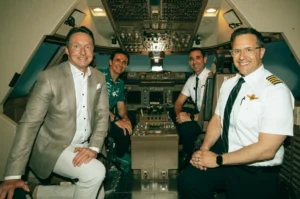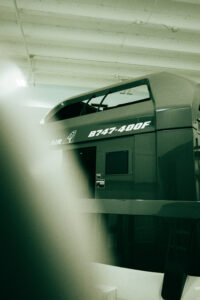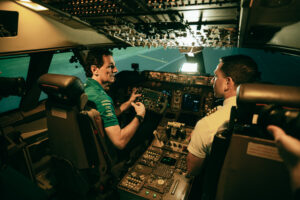
Commanding precision at 35,000 feet and 600 miles per hour. Could an F1 driver fly a Boeing 747? Our Official Logistics Partner, Atlas Air, put Aston Martin Aramco Team Ambassador Pedro de la Rosa in the cockpit simulator to find out.
Pedro de la Rosa has spent tens of thousands of miles in the cockpit but never behind the wheel… yoke… of an airplane, until now.
“I couldn’t relax for one second,” said Pedro. “My hands were aching because I was gripping the wheel so tight – it really felt like I was flying.”
The former F1 driver has competed in more than 100 Grands Prix, driven more than 65,000 test miles in F1 machinery and countless more in F1 simulators. But he found himself in the cockpit of a very different simulator at the Atlas Air’s Miami Training Centre to experience what it’s like to fly a Boeing 747 shortly after an Atlas Air freighter aircraft touched down at MIA with our cargo for the Miami Grand Prix.
The parallels of precision
 High speeds; rapid decision-making; complex controls; meticulous preparation, exceptional teamwork. F1 and aviation share many features.
High speeds; rapid decision-making; complex controls; meticulous preparation, exceptional teamwork. F1 and aviation share many features.
“Aviation and Formula 1 racing share incredible parallels, particularly in our pursuit of engineering precision, continuous innovation, and teamwork,” said Michael Steen, Chief Executive Officer of Atlas Air Worldwide. “We were fortunate to have Pedro join us to bring these similarities to life. As leaders in our respective fields, Atlas and Aston Martin Formula One are focused on staying true to our purpose, driven by passion and a commitment to winning.”
The mastery of machinery is key to both. Though an F1 steering wheel is much more compact than an airplane cockpit, the precise control of complex systems is paramount. From the cockpit, both driver and pilot must manage myriad systems, including electrical, hydraulic and engine. They’ve also got to be able to adapt. Just as pilots must adapt to changing weather and turbulence, drivers must adapt to weather conditions, temperatures and tire degradation.
Whether it’s pushing an F1 car to its limit at more than 200mph or safely guiding a 747 soaring at 35,000ft through the skies, both disciplines rely on optimal teamwork and clear communication. Coordinating with engineers and strategists is pivotal when making decisions in F1 to maximise performance, while successful flight operations depend on teamwork between the aircraft captain and first officer, as well as coordination from air traffic control.
In the cockpit
 Throughout a long and renowned career in F1, Pedro has helped refine the high-tech simulation processes that have become commonplace in modern 21st-century motorsport, making him uniquely placed to compare an F1 sim with its 747 counterpart.
Throughout a long and renowned career in F1, Pedro has helped refine the high-tech simulation processes that have become commonplace in modern 21st-century motorsport, making him uniquely placed to compare an F1 sim with its 747 counterpart.
“Like an F1 simulator, the 747 simulator is extremely realistic,” says Pedro, who completed his first ‘flight’ under the watchful eye of Atlas Air Regional Chief Pilot Andre Ortega. “I had the feeling that I was flying the real thing. The sense of risk and height were very real, and at one point, I even had vertigo. The key difference is that the response from the airplane is much slower than an F1 simulator. Everything takes a long time, but you still have to be very precise.”
Simulators are vital to both the world of F1 and the aviation industry as a method of training and developing drivers and pilots. Recreating tracks and cars realistically in the virtual world, simulators allow drivers to prepare for races and test various setups. Airline pilots also use simulators to train, allowing pilots to safely develop their skills, and experience emergency situations and advanced manoeuvres.
“It was a privilege to guide Pedro through our 747-flight simulator experience,” said Andre. “His ability to translate the discipline, focus, and instinct of a world-class driver onto the flight deck was impressive. Formula 1 and aviation share a deep reliance on precision, situational awareness, and seamless teamwork. Pedro brought that mindset into the pilot seat, and it was clear he understood what it means to command a complex machine responsibly. It was an honor to have the opportunity to share that moment with him.”
“Simulators are all about learning your environment and preparing you for reality,” explains Pedro. “In F1, we use simulators for performance and extracting everything from both the driver and the car. With the airplane simulator, it’s about getting to grips with the plane and flying in a safe manner.
“They’re very different disciplines with different priorities, but there’s an underlying similarity that you need to be very precise and very comfortable with your cockpit. You must know every detail of your machine. You need to know your tools, the buttons, the switches, the steering wheel, the pedals and everything else.
“You have to be completely focused on the job. There’s no room to make small mistakes. You have to be fully focused, and your attention must be completely on the simulator. I couldn’t relax for one second.”
Travelling the world together
 24 Grands Prix spanning 21 countries and five continents. An F1 team exists to go racing, but before it even turns a wheel on track, first it’s got to get to the circuit. Transporting freight seamlessly as we race across the globe is paramount to our performance, and that’s why we’re taking to the skies with a leading provider in aviation logistics, Atlas Air, to get us from A to B and beyond.
24 Grands Prix spanning 21 countries and five continents. An F1 team exists to go racing, but before it even turns a wheel on track, first it’s got to get to the circuit. Transporting freight seamlessly as we race across the globe is paramount to our performance, and that’s why we’re taking to the skies with a leading provider in aviation logistics, Atlas Air, to get us from A to B and beyond.
Atlas Air supports the transportation of cargo to select races throughout the season, helping us to get our freight to the track. Commanding the world’s largest fleet of 747 freighter aircraft, our Official Logistics Partner brings its unique knowledge and insights to our global operations, transporting and delivering our race equipment to many locations around the world, including Australia, China, the Middle East, and North and South America.
Rooted in our shared philosophies, our partnership succeeds due to our focus on precision, innovation and teamwork.
“Just spending 30 minutes in the cockpit taught me a lot,” says Pedro. “I have so much respect for the pilots, and there’s also a clear sense of passion and quality from Atlas Air that I can really relate to. This experience will always stay with me. I’m so grateful to Atlas Air for the opportunity.”
Watch the video below to see Pedro take to the skies in the Atlas Air simulator and discover the parallels between F1 and aviation.